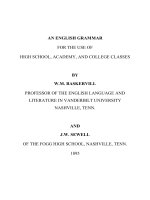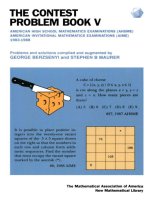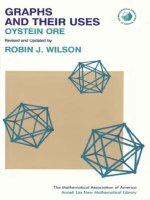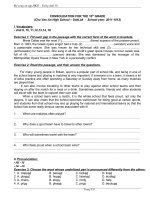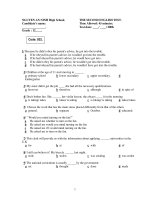the contest problem book iv annual high school examinations, 1973-1982
Bạn đang xem bản rút gọn của tài liệu. Xem và tải ngay bản đầy đủ của tài liệu tại đây (4.73 MB, 158 trang )
GRAPHS
AND
THEIR
USES
by
Oystein
Ore
Yale
University
Revised
and
updated
edition
prepared
by
Robin
J.
Wilson
The
Open
University,
England
34
THE
MATHEMATICAL
ASSOCIATION
OF
AMERICA
©
Copyright,
1990,
The
Mathematical
Association
of
America
All
rights
reserved
under
International
and
Pan-American
Copyright
Conventions.
Published
in
Washington
by
the
Mathematical
Association
of
America
Library
of
Congress
Catalog
Card
Number:
90-061132
Complete
Set
ISBN
0-88385-600-X
Vol.
340-88385-635-2
Manufactured
in
the
United
States
of
Amenca
Note
to
the
Reader
T
his
book
is
one
of
a
series
written
by
professional
mathemati-
cians
in
order
to
make
some
important
mathematical
ideas
interesting
and
understandable
to
a
large
audience
of
high
school
students
and
laymen.
Most
of
the
volumes
in
the
New
Mathematical
Library
cover
topics
not
usually
included
in
the
high
school
curricu-
lum;
they
vary
in
difficulty,
and,
even
within
a
single
book,
some
parts
require
a
greater
degree
of
concentration
than
others.
Thus,
while
you
need
little
technical
knowledge
to
understand
most
of
these
books,
you
will
have
to
make
an
intellectual
effort.
If
you
have
so
far
encountered
mathematics
only
in
classroom
work,
you
should
keep
in
mind
that
a
book
on
mathematics
cannot
be
read
quickly.
Nor
must
you
expect
to
understand
all
parts
of
the
book
on
first
reading.
You
should
feel
free
to
skip
complicated
parts
and
return
to
them
later;
often
an
argument
will
be
clarified
by
a
subsequent
remark.
On
the
other
hand,
sections
containing
thor-
oughly
familiar
material
may
be
read
very
quickly.
The
best
way
to
learn
mathematics
is
to
do
mathematics,
and
each
book
includes
problems,
some
of
which
may
require
considerable
thought.
You
are
urged
to
acquire
the
habit
of
reading
with
paper
and
pencil
in
hand;
in
this
way,
mathematics
will
become
increasingly
meaningful
to
you.
The
authors
and
editorial
committee
are
interested
in
reactions
to
the
books
in
this
series
and
hope
that
you
will
write
to:
Anneli
Lax,
Editor,
New
Mathematical
Library,
NEW YORK UNIVERSITY, THE
COURANT
INSTITUTE
OF
MATHEMATICAL
SCIENCES, 251
Mercer
Street,
New
York,
N.
Y.
10012.
The
Editors
NEW
MATHEMATICAL
LIBRARY
1
Numbers:
Rational
and
Irrational
by
Ivan
Niven
2
What
is
Calculus
About?
by
W.
W.
Sawyer
3
An
Introduction
to
Inequalities
by
E.
F.
Beckenbach
and
R.
Bellman
4
Geometric
Inequalities
by
N.
D.
Kazarinoff
5
The
Contest
Problem
Book
I
Annual
Hlgh
Scbool
Mathematics
ExanunatiolU
1950-1960.
Compiled
and
with
solullons
by
Charles T.
Sal
kind
6
The
Lore
of
Large
Numbers,
by
P.
J.
Davis
7
Uses
of
Infinity
by
Leo
Zippin
8
Geometric
Transformations
I
by
I.
M.
Yaglom,
translated
by
A.
Shields
9
Continued
Fractions
by
Carl
D.
Olds
10
Graphs
and
Their
Uses
by
Oystein
Ore
11}
Hungarian
Problem
Books
I
and
II,
Based
on
the
EOtvc>s
12
Competitions
1894-1905
and
1906-1928.
translated
by
E.
Rapaport
13
Episodes
from
the
Early
History
of
Mathematics
by
A.
A
aboe
14
Groups
and
Their
Graphs
by
I.
Grossman
and
W.
Magnus
15
The
Mathematics
of
Choice
by
Ivan
Niven
16
From
Pythagoras
to
Einstein
by
K.
O.
Friedrichs
17
The
Contest
Problem
Book
II
Annual
Hlgh
Scbool
Matbematics
Examinations
1961-1965
Compiled
and
with
solutiolU
by
Charles
T.
Salkind
18
First
Concepts
of
Topology
by
W.
G.
Chinn
and
N.
E.
Steenrod
19
Geometry
Revisited
by
H.
S.
M.
Coxeter
and
S
L.
Greitzer
20
Invitation
to
Number
Theory
by
Oystein
Ore
21
Geometric
Transformations
II
by
I.
M.
Yaglom,
translated
by
A.
Shields
22
Elementary
Cryptanalysis-A
Mathematical
Approach
by
A.
Sinkov
23
Ingenuity
in
Mathematics
by
Ross
Honsberger
24
Geometric
Transformations
III
by
I.
M.
Yaglom,
translated
by
A.
Shenitzer
25
The
Contest
Problem
Book
III
Annual
High
Scbool
Mathematics
Examinallons
1966-1972
Compiled
and
with
solullons
by
C T
Salkind
and
J.
M.
Earl
26
Mathematical
Methods
in
Science
by
George
Pblya
27
International
Mathematical
Olympiads-1959-1977.
Compiled
and
with
solullons
by
S.
L.
Greilzer
28
The
Mathematics
of
Games
and
Gambling
by
Edward
W.
Packel
29
The
Contest
Problem
Book
IV
Annual
High
Scbool
Matbemaucs
Exanunations
1973-1982
Compiled
and
witb
solutions
by
R.
A.
Artino,
A.
M Gaglione
and
N.
Shell
30
The
Role
of
Mathematics
in
Science
by
M.
M.
Schiffer
and
L.
Bowden
31
International
Mathematical
Olympiads
1978-1985
and
forty
supplementary
problems.
Compiled
and
with
solutions
by
Murray
S.
Klamkin
32
Riddles
of
the
Sphinx
by
Martin
Gardner
33
U.S.A.
Mathematical
Olympiads
1972-1986.
Compiled
and
with
solutions
by
Murray
S.
Klamkin
34
Graphs
and
Their
Uses,
by
Oystein Ore.
Revised
and
updated
by
Robin
J. Wilson.
Other
litles
in
preparation.
Contents
Introduction
3
Chapter
1
What
Is
a
Graph?
5
1.1
Team
Competitions
5
1.2
Null
Graphs
and
Complete
Graphs
7
1.3
Isomorphic
Graphs
9
1.4
Planar
Graphs
12
1.5
Planar
Problems
14
1.6
The
Number
of
Edges
in
a
Graph
18
1.7
Interval
Graphs
21
Chapter
2
Connected
Graphs
24
2.1
Connected
Components
24
2.2
The
Problem
of
the
Bridges
of
Konigsberg
26
2.3
Eulerian
Graphs
27
2.4
Finding
Your
Way
30
2.5
Hamiltonian
Cycles
31
2.6
Puzzles
and
Graphs
33
Chapter
3
Trees
37
3.1
Trees
and
Forests
37
3.2
Cycles
and
Trees
39
3.3
The
Connector
Problem
41
3.4
The
Travelling
Salesman
Problem
Revisited
44
3.5
Bracing
Frameworks
46
3.6
Streets
and
Squares
49
vii
viii
Chapter
4
4.1
4.2
4.3
Chapter
5
5.1
5.2
5.3
5.4
5.5
Chapter
6
6.1
6.2
6.3
Chapter
7
7.1
7.2
7.3
7.4
Chapter
8
8.1
8.2
8.3
8.4
8.5
Chapter
9
9.1
9.2
9.3
Solutions
Bibliography
Glossary
Index
GRAPHS
AND
THEIR
USES
Matchings
The
Jobs
and
the
Applicants
Other
Formulations
Round-Robin
Matchings
Directed
Graphs
Team
Competitions
Re-examined
The
Problems
of
One-Way
Traffic
Degrees
Genetic
Graphs
Finding
the
Shortest
Route
Questions
Concerning
Games
and
Puzzles
Puzzles
and
Directed
Graphs
The
Theory
of
Games
The
Sportswriter's
Paradox
Relations
Relations
and
Graphs
Special
Conditions
Equivalence
Relations
Partial
Orders
Planar
Graphs
Conditions
for
Planar
Graphs
Euler's
Formula
Graph
Relations
and
Dual
Graphs
The
Platonic
Solids
Mosaics
Map
Coloring
The
Four
Color
Problem
The
Five
Color
Theorem
Coloring
Maps
on
Other
Surfaces
53
53
56
59
63
63
63
70
72
78
83
83
86
90
95
95
97
101
105
109
109
113
115
117
121
125
125
129
133
136
146
148
151
INTRODUCTION
TO
THE
FIRST
EDITION
The
term
"graph"
in
this
book
denotes
something
quite
different
from
the
graphs
you
may
be
familiar
with
from
analytic
geometry
or
function
theory.
The
kind
of
graph
you
probably
have
dealt
with
consisted
of
the
set
of
all
points
in
the
plane
whose
coordinates
(x,
y),
in
some
coordinate
system,
satisfy
an
equation
in
x
and
y.
The
graphs
we
are
about
to
study
in
this
book
are
simple
geometrical
figures
consisting
of
points
and
lines
connecting
some
of
these
points;
they
are
sometimes
called
"linear
graphs".
It
is
unfortunate
that
two
different
concepts
bear
the
same
name,
but
this
terminology
is
now
so
well
established
that
it
would
be
difficult
to
change.
Similar
ambiguities
in
the
names
of
things
appear
in
other
mathematical
fields,
and
unless
there
is
danger
of
serious
confusion,
mathemati-
cians
are
reluctant
to
alter
the
terminology.
The
first
paper
on
graph
theory
was
written
by
the
famous
Swiss
mathematician
Euler,
and
appeared
in
1736.
From
a
mathematical
point
of
view,
the
theory
of
graphs
seemed
rather
insignificant
in
the
beginning,
since
it
dealt
largely
with
entertaining
puzzles.
But
recent
developments
in
mathematics,
and
particularly
in
its
applications,
have
given
a
strong
impetus
to
graph
theory.
Already
in
the
nine-
teenth
century,
graphs
were
used
in
such
fields
as
electrical
circuitry
and
molecular
diagrams.
At
present
there
are
topics
in
pure
mathe-
matics-for
instance,
the
theory
of
mathematical
relations-where
graph
theory
is a
natural
tool,
but
there
are
also
numerous
other
uses
in
connection
with
highly
practical
questions:
matchings,
trans-
portation
problems,
the
flow
in
pipeline
networks,
and
so-called
"programming"
in
general.
Graph
theory
now
makes
its
appearance
in
such
diverse
fields
as
economics,
psychology
and
biology.
To
a
small
extent
puzzles
remain
a
part
of
graph
theory,
particularly
if
one
includes
among
them
the
famous
four
color
map
problem
that
in-
trigues
mathematicians
today
as
much
as
ever.
In
mathematics,
graph
theory
is
classified
as
a
branch
of
topology;
but
it
is
also
strongly
related
to
algebra
and
matrix
theory.
In
the
following
discussion
we
have
been
compelled
to
treat
only
the
simplest
problems
from
graph
theory;
we
have
selected
these
3
4
GRAPHS
AND
THEIR
USES
with
the
intention
of
giving
an
impression,
on
the
one
hand,
of
the
kind
of
analyses
that
can
be
made
by
means
of
graphs
and,
on
the
other
hand,
of
some
of
the
problems
that
can
be
attacked
by
such
methods.
Fortunately,
no
great
apparatus
of
mathematical
computa-
tion
needs
to
be
introduced.
INTRODUCTION
TO
THE
REVISED
EDITION
O.Ore
In
preparing
this
edition
I
have
endeavored
to
stick
as
closely
as
possible
to
Oystein
Ore's
original
intentions.
However,
I
have
felt
free
to
make
a
large
number
of
minor
changes
in
the
presentation
and
layout
of
the
material,
and
I
have
updated
the
terminology
and
notation
so
as
to
bring
them
in
line
with
contemporary
usage.
I
have
also
added
new
material
on
interval
graphs,
the
travelling
salesman
problem,
bracing
frameworks,
shortest
route
problems,
and
coloring
maps
on
surfaces.
Most
of
the
diagrams
in
the
book
have
been
redrawn.
I
have
always
regarded
Ore's
text
as
a
classic,
and
working
on
this
second
edition
has
served
to
reinforce
this
view.
It
is
my
hope
that
this
edition
will
enable
a
new
generation
of
readers
to
derive
as
much
pleasure
from
Ore's
book
as
my
generation
did
in
the
1960s
and
1970s.
R.
J.
Wilson
CHAPTER
ONE
What
is
a Graph?
1.1
Team
Competitions
Suppose
that
your
school
football
team
belongs
to
a
league
in
which
it
plays
the
teams
of
certain
other
schools.
Call
your
own
team
a
and
the
other
teams
b,
c,
d,
e
and
f,
and
assume
that
there
are
6
teams
altogether.
After
a few
weeks
of
the
season
have
passed
some
of
the
teams
will
have
played
each
other-for
instance,
a
has
played
c,
d,
f
b
has
played
c,
e,
j
c
has
played
a,
b
d
has
played
a,
e,
f
e
has
played
b,
d,
f
j
has
played
a,
b,
d,
e.
To
illustrate
this
situation
we
can
use
a
geometric
diagram.
Each
team
can
be
represented
by
a
point
or
a
little
circle,
and
two
such
points
can
be
connected
by
a
straight
line
whenever
the
teams
they
represent
have
played
their
game.
Then
the
above
list
of
completed
games
can
be
presented
as
in
Figure
1.1.
A figure
such
as
the
one
drawn
in
Figure
1.1
is
called
a
graph.
It
consists
of
certain
points
a,
b,
c,
d,
e,
j,
called
its
vertices,
and
certain
line
segments
connecting
vertices
(such
as
ac,
eb,
etc.),
called
the
edges
of
the
graph.
We
shall
call
this
graph
G.
5
6
GRAPHS
AND
THEIR
USES
a
d
Figure
11
It
may
happen,
as
we
see
from
Figure
1.1,
that
the
edges
of
a
graph
intersect
without
the
intersection
being
a
vertex;
this
complication
is
due
to
the
fact
that
we
drew
our
graph
in
the
plane.
Therefore,
it
might
have
been
more
appropriate
to
represent
the
edges
as
threads
passing
over
each
other
in
space;
but
in
any
case
the
marking
of
the
vertices
should
be
done
with
sufficient
care
to
prevent
confusion.
Any
set
of
games
played
in
a
team
tournament
can
be
depicted
as
a
graph
in
the
manner
described.
On
the
other
hand,
if
one
has
some
graph
(that
is, a figure
consisting
of
points
or
vertices
connected
by
line
segments
or
edges),
then
it
can
be
interpreted
as
the
diagram
of
such
a
competition.
As
an
illustration
let
us
take
the
graph
drawn
in
Figure
1.2.
The
figure
may
be
considered
to
depict
a
competition
between
8
teams;
a
has
played
with
the
teams
b,
e,
d,
while b
has
played
with
a,
t,
g,
c,
and
so
on.
a
d~~ ~"c
Figure
1 2
WHAT
IS
A
GRAPH?
7
Problem
Set
1.1
1.
Draw
the
graph
of
the
games
played
at
mid-season
in
your
football
or
baseball
circuit.
2.
Write
a
complete
list
of
the
games
played
in
the
graph
in
Figure
1.2.
3.
How
many
vertices
and
edges
are
there
in
the
graphs
in
Figure
1.1
and
Figure
1.2,
respectively?
1.2
Null
Graphs
and
Complete
Graphs
There
are
certain
special
graphs
which
turn
up
in
many
uses
of
graph
theory.
For
the
moment
let
us
stick
to
our
interpretation
of
a
graph
as
a
pictorial
record
of
team
competitions.
Before
the
season
starts,
when
no
games
have
been
played,
there
will
be
no
edges
in
the
graph.
Thus
the
graph
will
consist
only
of
isolated
vertices-that
is,
vertices
at
which
there
are
no
edges.
We
call
a
graph
of
this
kind
a
null
graph.
In
Figure
1.3
we
have
drawn
such
graphs
for
1,
2,3,4
and
5
teams
or
vertices.
These
null
graphs
are
commonly
denoted
by
the
symbols
N
l
,
N
2
,
N
3
,
and
so
on,
so
that
in
general
Non
is
the
null
graph
with
n
vertices
and
no
edges.
•
•
•
2
•
•
•
3
Figure
1 3
•
•
• •
4
•
•
•
• •
5
N
ext
let
us
go
to
another
extreme.
When
the
season
is
over
we
suppose
that
each
team
has
played
just
once
with
every
other
team.
Then
in
the
game
graph
each
pair
of
vertices
is
connected
by
an
edge.
Such
a
graph
is
called
a
complete
graph.
Figure
1.4
shows
the
complete
graphs
for
n =
1,2,3,4,5
vertices.
We
denote
these
com-
plete
graphs
by
K
1
,
K
2
•
K
3
•
K
4
,
K
5
•
respectively,
so
that
in
general
K n
consists
of
n
vertices
and
the
edges
connecting
all
pairs
of
these
vertices.
It
can
be
drawn
as
a
polygon
with
n
sides
and
with
all
its
diagonals.
•
1
2
3
4
5
Figure
1 4
8
GRAPHS
AND
THEIR
USES
When
one
has
drawn
some
graph-for
instance,
the
graph
G
in
Figure
1.1-one
can
always
make
it
into
a
complete
graph
with
the
same
vertices
by
adding
the
missing
edges-
that
is,
the
edges
which
correspond
to
games
still
to
be
played.
In
Figure
1.5
we
have
done
this
for
the
graph
G
in
Figure
1.1.
(Games
not
yet
played
are
represented
by
broken
lines.)
a
e
d
Figure
15
One
can
also
draw
separately
the
graph
consisting
exclusively
of
the
unplayed,
future
games.
In
the
case
of
the
graph
G,
this
results
in
the
graph
depicted
in
Figure
1.6.
a
f
7
b
"""
/
y
//
_ :;? ~-__;::;_
c
~
, ,-"'"
e
d
Figure
1 6
WHAT
IS
A
GRAPH?
9
This
new
graph
in
Figure
1.6
we
call
the
complement
of
the
graph
G
in
Figure
1.1,
and
it
is
customary
to
denote
it
by
G.
If
we
take
the
complement
of
G,
we
get
back
to
G;
together
the
edges
in
the
two
graphs
G
and
G
make
up
the
complete
graph
connecting
their
vertices.
Problem
Set
1.2
1.
Draw
the
complement
of
the
graph
in
Figure
1.2.
2.
How
many
edges
have
the
complete
graphs
Ks,
K6
and
K/!
3.
Express
in
terms
of
n
the
number
of
edges
in
the
complete
graph
Kn.
1.3
Isomorphic
Graphs
Notice
that,
in
drawing
the
graph
in
Figure
1.1,
we
have
a
good
deal
of
freedom.
First,
there
is
no
necessity
for
the
edges
to
be
straight
lines.
Any
kind
of
curves
will
do
as
long
as
they
connect
the
same
vertices
as
before.
For
example,
we
can
present
the
graph
in
Figure
1.1
in
the
following
form
(Figure
1.7):
a
Figure
1 7
Second,
we
can
place
the
vertices
in
arbitrary
positions
in
the
plane.
The
graph
in
Figure
1.1,
for
instance,
can
be
drawn
with
the
vertices
placed
as
in
Figure
1.8.
10
GRAPHS
AND
THEIR
USES
a
d ,.
___
_
e
f
Figure
1 8
If
we
consider
the
three
graphs
in
Figure
1.1,
Figure
1.7
and
Figure
1.8
as
the
graphs
of
tournament
games,
they
all
contain
exactly
the
same
information
in
regard
to
which
teams
have
played
each
other-that
is,
they
are
in
a
sense
the
same
graph.
This
leads
us
to
say
in
general
that
two
graphs,
G
l
and
G
2
are
isomorphic
if
they
represent
the
same
situation.
In
other
words,
if
G
l
and
G
2
are
isomorphic,
then
they
have
the
same
number
of
vertices,
and
whenever
two
vertices
in
G
I
,
say
b
i
and
Cl'
are
connected
by
an
edge,
then
the
corresponding
vertices
b
2
and
c
2
in
G
2
are
also
connected
by
an
edge,
and
vice versa.
According
to
this
definition
the
three
graphs
in
Figure
1.1,
Figure
1.7,
and
Figure
1.8
are
isomorphic
in
spite
of
the
fact
that
they
have
been
drawn
in
different
manners.
(The
term
"isomorphic"
is
a
much
used
one
in
mathematics;
it
is
derived
from
the
Greek
words
iso-
the
same,
and
morphe-form.)
Often
one
is
faced
with
the
problem
of
deciding
whether
two
graphs
are
isomorphic.
At
times
there
are
obvious
reasons
why
this
cannot
be
the
case.
For
example,
the
graphs
in
Figure
1.9
cannot
be
isomorphic
Figure
1 9
WHAT
IS
A
GRAPH?
11
because
they
do
not
have
the
same
number
of
vertices.
Nor
can
the
graphs
in
Figure
1.10
be
isomorphic,
since
they
do
not
have
the
same
number
of
edges.
Figure
1
10
Slightly
more
subtle
reasoning
is
required
to
show
that
the
two
graphs
in
Figure
1.11
are
not
isomorphic.
One
can
observe,
however,
that
in
the
first
graph
the
vertices
a,
b,
c, d
with
two
edges
emerging
from
them
are
joined
in
pairs
(ab
and
cd),
whereas
in
the
second
graph
they
are
not
so
joined.
In
other
words,
no
matter
how
we
name
the
vertices
of
the
second
graph,
we
shall
not
be
able
to
match
pairs
of
vertices
connected
by
an
edge
in
one
graph
with
corresponding
pairs
of
vertices
connected
by
an
edge
in
the
other
graph.
a
a
h
d
Figure
1
11
When
there
is
no
obvious
way
to
show
that
two
given
graphs
are
not
isomorphic,
it
may
be
quite
difficult
to
decide
whether
we
can
name
the
vertices
in
such
a
manner
that
we
obtain
an
isomorphism
between
the
graphs.
As
an
example,
consider
the
two
graphs
in
Figure
12
GRAPHS
AND
THEIR
USES
1.12~
they
are
actually
isomorphic,
as
we
ask
you
to
show
in
Problem
3,
below.
Figure
112
The
determination
of
efficient
criteria
for
deciding
whether
two
given
graphs
are
isomorphic
is
one
of
the
major
concerns
in
current
graph
theory.
As
the
number
of
vertices
increases,
the
number
of
ways
of
naming
them
grows
very
fast,
and
isomorphisms
between
the
graphs
become
very
hard
to
find,
even
with
a
computer.
Problem
Set
1.3
1.
Show
that
the
graphs
in
Figure
1.1,
Figure
1.2
and
Figure
1.6
are
not
isomorphic
to
each
other
2.
Give
another
reason
why
the
two
graphs
in
Figure
1.11
cannot
be
isomor-
phic.
3.
Name
the
vertices
in
the
two
graphs
in
Figure
1.12
so
that
their
isomor-
phism
becomes
evident.
1.4
Planar
Graphs
For
many
purposes,
it
does
not
matter
how
a
graph
is
drawn;
that
is,
isomorphic
graphs
may
be
considered
to
be
the
same
since
they
give
the
same
information.
This
was
certamly
the
case
in
our
initial
interpretation
of
graphs
as
the
record
of
games
between
teams.
However,
as
we
shall
point
out
presently,
there
are
purposes
for
which
it
is
essential
that
a
graph
can
be
drawn
in
a
particular
way.
Let
us
compare
the
two
isomorphic
graphs
in
Figure
1.1
and
Figure
1.7.
In
the
first
drawing,
the
edges
intersect
at
5
points
that
are
not
vertices
of
the
graph.
On
the
other
hand,
in
Figure
1.7
the
edges
intersect
only
at
vertices.
WHAT
IS
A
GRAPH?
13
A
graph
which
can
be
drawn
in
such
a
way
that
the
edges
have
no
intersections
or
common
points
except
at
the
vertices
is
called
a
planar
graph.
Thus
the
graph
in
Figure
1.1
is
planar
because
there
exists
a
representation
of
it
in
the
plane
as
in
Figure
1.7.
A
planar
graph
can
be
interpreted
as
a
road
map
showing
the
connections
between
various
road
junctions
or
villages.
For
instance,
the
map
in
Figure
1.13
indicates
that
there
are
7
junctions,
a
to
g.
some
of
which
are
directly
connected
by
roads,
such
as
ag,
be,
fe,
and
so
on.
Conversely.
a
road
map
can
be
considered
to
be
a
planar
graph.
Similarly.
a
city
map
can
be
regarded
as
a
planar
graph
with
the
streets
as
edges
and
the
street
intersections
as
vertices-see
Figure
1.14.
b
f
Figure
1.l3
Figure
1.14
14
GRAPHS
AND
THEIR
USES
Modem
technology
has
changed
many
things.
and
we
must
recog-
nize
that
it
has
modified
the
preceding
simple
conception
of
road
maps
as
planar
graphs.
To
our
road
net
have
been
added
throughways
with
limited
access,
so
that
often
two
roads
cross
without
permitting
passage
from
one
to
the
other;
in
other
words,
the
edges
of
the
map
graph
intersect
at
points
which
are
not
road
junctions
and
thus
the
corresponding
graph
is
not
a
planar
graph.
Figure
L15
shows
a
road
intersection
which
illustrates
this
very
effectively.
Figure
115
Problem
Set
1.4
1.
From
an
automobile map, draw a
planar
road
graph
for a certain section
of
your
state.
2.
Do
the
same
for a city map.
1.5
Planar
Problems
We
shall
now
consider
two
instances
of
the
use
of
graphs
in
problem
solving.
In
both
cases
it
is
essential
to
decide
whether
or
not
a
graph
can
be
drawn
in
the
plane
without
intersections
of
the
edges.
WHAT
IS
A
GRAPH?
15
As
our
first
illustration,
let
us
turn
to
a
very
ancient
puzzle
(sometimes
called
the
Utilities
Problem):
Three
houses
have
been
built
on
a
piece
of
land,
and
three
wells
have
been
dug
for
the
use
of
the
occupants.
The
nature
of
the
land
and
the
climate
are
such
that
one
or
another
of
the
wells
frequently
runs
dry;
it
is
therefore
important
that
the
people
of
each
house
have
access
to
each
of
the
three
wells.
After
a while,
the
residents
a,
b
and
c
develop
rather
strong
dislikes
for
one
another
and
decide
to
con-
struct
paths
to
the
three
wells
x,
y,
z
in
such
a
manner
that
they
avoid
meeting
each
other
on
their
way
to
and
from
the
wells.
In
Figure
1.16,
we
see
the
graph
of
the
arrangement
in
which
each
owner
uses
the
most
direct
paths
to
the
wells.
These
paths
or
edges
intersect
in
many
points
aside
from
the
houses
a,
b,
c,
and
the
wells
x,y,
z.
The
number
of
intersections
can
be
reduced
to
a
single
one,
provided
we
draw
the
paths
as
indicated
in
Figure
1.17.
a
b
c
x
v
z
Figure
116
Figure
117
16
GRAPHS
AND
THEIR
USES
The
question
we
should
like
to
answer
is
the
following:
can
we
trace
the
paths
so
that
the
graph
is
planar-that
is,
without
any
edge
intersections?
Try
as
you
may,
you
will
find
no
such
tracing.
However,
our
inability
to
solve
this
problem
by
trial
and
error
does
not
constitute
a
mathematical
proof
that
no
such
tracing
exists.
A
mathe-
matical
proof
can
be
given
and
is
based
on
the
following
result
(see
Figure
1.18):
JORDAN
CURVE
THEOREM.
Suppose
C
is
a
continuous
closed
curve
in
the
plane-it
may
be
a
polygon,
a circle,
an
ellipse,
or
some
more
complicated
type
of
curve.
Then
C
divides
the
plane
into
an
outer
part
and
an
inner
part,
so
that
whenever
any
point
p
in
the
inner
part
is
connected
to
a
point
q
in
the
outer
part
by
a
continuous
curve
L
in
the
plane,
then
L
intersects
C.
q
Figure
118
You
probably
feel
that
this
is
perfectly
obvious,
and,
from
an
intuitive
geometric
view,
it
is.
The
difficulty
lies
in
the
precise
defini-
tion
of
"curve",
which
we
omit
here,
together
with
the
proof
of
the
Jordan
curve
theorem.
You
may
take
the
theorem
as
an
evident
fact.
This
theorem
implies
the
intuitively
obvious
result
that
if
any
two
points
on
the
closed
curve
C,
say
a
and
y,
are
connected
by
a
curve
ay
which
has
no
other
points
in
common
with
C,
then,
except
for
its
end
points,
ay
lies
entirely
either
inside
or
outside
of
C.
(See
Figure
1.19.)
Suppose
next
that
there
are
4
points
on
C
lying
in
the
order
abyz
and
that
there
are
curves
ay
and
bz
having
no
intersections
with
each
other.
This
is
only
possible
when
one
of
the
curves,
say
ay,
lies
inside
C
while
the
other,
bz,
is
outside
(see
Figure
1.19).
This
can
be
proved
by
Jordan's
theorem,
but
you
may
(as
we
have
done)
take
it
as
a
fact
that
needs
no
further
justification.
Finally,
let
there
be
6
points
on
C
following
in
the
order
a,
x,
b,
y,
c,
z
(see
Figure
1.19).
Then
it
is
impossible
that
there
are
WHAT
IS
A
GRAPH?
z
_ _c:-: :-
_,
c",
,
\
,
,
J
",""
Figure
1.19
17
three
connecting
curves
ay.
bz
and
ex
without
intersections.
To
see
this,
observe
that
the
three
curves
must
be
placed
into
two
regions,
the
inside
of
C
and
the
outside
of
C;
therefore
at
least
two
of
the
curves
fall
into
the
same
region
and,
by
the
considerations
above,
this
would
lead
to
intersections.
This
argument
applies
immediately
to
our
problem
of
the
three
unfriendly
neighbors
and
their
wells.
Suppose
that
the
corresponding
graph
in
Figure
1.16
were
planar.
Then,
in
any
drawing
without
edge
intersections,
the
edges
ax,
xb,
by,
ye,
cz
and
za
would
form
a
closed
curve
in
the
plane.
But
then,
for
the
reason
we
just
explained,
there
can
be
no
edges
ay,
bz
and
ex
without
intersections.
This
illustration
of
the
use
of
planar
graphs
may
seem
somewhat
trivial;
however,
one
should
never
despise
these
apparently
small,
but
puzzling,
problems.
In
numerous
instances,
they
have
been
the
seeds
from
which
important
mathematical
ideas
have
evolved.
It
may
re-
mind
us
also
that
a
heavy
machinery
of
symbols
and
formulas
is
not
always
the
best
criterion
for
judging
the
depth
of
a
mathematical
theory.
We
can
also
indicate
an
application
of
planar
graphs
to
an
emi-
nently
practical
problem.
In
addition
to
the
previous
interpretations,
a
graph
can
be
thought
of
as
the
diagram
for
an
electrical
network,
with
the
edges
representing
the
conducting
wires
connecting
the
various
junctions.
One
of
the
most
effective
ways
of
mass
producing
a
standard
network
for
a
radio
or
television
set
is
to
•
print'
the
wires
on
a
base
of
board
or
plastic.
In
order
for
this
to
be
feasible,
the
network
graph
in
question
must
have
a
planar
representation,
since
otherwise
the
intersection
of
two
edges
would
produce
a
short
circuit
in
the
system.
Such
applications
of
planar
graphs
have
become
increasingly
important
in
recent
years
with
the
rapid
developments
in
electronics.
18
GRAPHS
AND
THEIR
USES
Problem
Set
1.5
1.
Show how
each
of
four neighbors
can
connect his house with the
other
three
houses
by
paths
which
do
not
cross.
2. A fifth
person
builds a house nearby; prove
that
he
cannot
connect his
house
with
all the others
by
non-intersecting
paths,
but
that
he
can
connect
it
with three
of
the others.
1.6
The
Number
of
Edges
in
a
Graph
In
introducing
a
graph
as
the
record
of
a
series
of
played
games,
we
assumed
that
at
most
one
game
was
played
between
any
two
teams.
It
may
of
course
happen
that
two
teams
play
many
games,
as
they
do
in
the
baseball
leagues.
We
can
take
this
into
account
in
the
graph
by
drawing
several
edges
ab
connecting
the
two
corresponding
teams
or
vertices
(Figure
1.20).
We
then
say
that
the
graph
has
multiple
edges.
b
a
Figure
1.20
Instead
of
actually
drawing
the
various
edges
between
a
and
b,
we
could
also
use
a
single
edge
and
assign
a
number
or
multiplicity
to
it
to
indicate
how
many
times
this
edge
should
be
repeated
(Figure
1.21).
On
a
road
map.
it
is
of
course
customary
to
draw
each
road
separately
between
the
two
junctions.
b
a
Figure
121
WHAT
IS
A
GRAPH?
19
At
each
non-isolated
vertex
a
in
a
graph
G,
there
will
be
some
edges
having
a
as
an
endpoint;
these
edges
are
said
to
be
incident
to
a.
The
number
of
such
edges
we
usually
denote
by
deg(a),
and
call
it
the
degree
of
a.
To
illustrate,
we
observe
that
the
graph
in
Figure
1.1
has
degrees
deg(
a)
=
deg(
b)
=
deg(
d)
=
deg(
e)
=
3,
deg(f)
=
4,
deg(c)
=
2.
For
many
purposes
we
are
interested
in
finding
the
number
of
edges
in
the
graph.
They
can
of
course
be
counted
directly,
but
it
is
often
easier
to
count
the
number
of
edges
at
each
vertex
and
add
them.
Then
each
edge
has
been
counted
twice,
once
at
each
of
its
two
end
points,
so
the
number
of
edges
in
the
graph
is
half
this
sum.
For
instance,
the
number
of
edges
in
the
graph
in
Figure
1.1
is
t{deg(a)
+
deg(b)
+
deg(c)
+
deg(d)
+
deg(e)
+
deg(f)}
=
9,
as
we
also
see
directly.
To
formulate
this
quite
generally,
assume
that
G
is
a
graph
with
n
vertices
ai'
a
2
••••
,
an'
and
having
as
degrees
the
numbers
deg(
all,
deg(
a
2
),·
• • ,
deg(
an)'
Then
the
number
m
of
edges
in
G is,
by
our
argument,
m = H
deg(
ad
+
+
deg(
an)
} .
This
result
is
sometimes
called
the
handshaking
lemma,
and
has
the
consequence
that
in
any
graph
the
sum
of
the
degrees
deg(
all
+
+
deg(
an)
is
an
even
number-
namely,
twice
the
number
of
edges.
I t
is
due
to
the
Swiss
mathematician
Leonhard
Euler
(1707-1783),
whom
you
will
meet
again
in
Chapter
2.
In
a
graph
there
are
two
types
of
vertices,
the
odd
vertices
whose
degree
is
an
odd
number,
and
the
even
vertices
whose
degree
is
an
even
number.
In
the
case
of
the
graph
in
Figure
1.1,
the
vertices
a,
b,
d,
e
are
odd
while
the
vertices
c
and
f
are
even.
When
the
vertices
are
taken
in
alphabetical
order
the
sum
of
the
degrees
becomes
3 + 3 + 2 + 3 + 3 + 4 =
18.
This
sum
is
even,
for
there
are
4
terms
which
are
odd
numbers.
To
decide
in
general
whether
a
sum
of
integers
is
odd
or
even,
we
can
disregard
the
even
terms;
the
sum
is
even
or
odd
depending
upon
20
GRAPHS
AND
THEIR
USES
whether
it
contains
an
even
or
an
odd
number
of
odd
summands.
When
we
apply
this
observation
to
the
fact
that
the
sum
of
the
degrees
is
even,
we
arrive
at
the
following
result:
THEOREM
1.1.
A
graph
has
an
even
number
of
odd
vertices.
(We
include
in
this
statement
the
case
where
there
are
no
odd
vertices,
since
0
is
an
even
number.)
There
are
special
graphs
in
which
all
degrees
are
the
same:
The
graph
is
then
called
regular
of
degree
r
and,
according
to
the
handshaking
lemma,
the
number
of
its
edges
is
m =
tnr,
where
n
is
the
number
of
vertices.
The
graphs
in
Figure
1.22
are
regular
of
degree
3
and
4,
respectively.
Figure
1
22
In
the
complete
graph
K n
with
n
vertices
there
are
n - 1
edges
from
each
vertex
to
the
others,
so
that
K n is
regular
of
degree
n - 1.
The
null
graph
N
n
is
also
regular
in
a
trivial
way,
since
the
degree
of
each
vertex
is
o.
Problem
Set
1.6
1.
Check
the
handshaking
lemma
for
the
number
of
edges
in
the
graphs
in
Figures
1 2
and
1.6.
2.
Verify
that,
for
these
graphs,
the
number
of
odd
vertices
is
even



